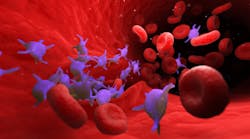To take the test online go HERE. For more information, visit the Continuing Education tab.
LEARNING OBJECTIVES
Upon completion of this article, the reader will be able to:
1. Discuss healthcare statistics and the causative agent of syphilis.
2. Describe the different stages of syphilis.
3. Describe detection methods and types of assays for syphilis and their limitations.
4. Discuss the algorithms used in the diagnosis of syphilis and their limitations.
Syphilis, a sexually transmitted infection caused by the organism Treponema pallidum, manifests as a genital ulcerative disease. While the prevalence of syphilis in the United States reached historically low levels in 2000 and 2001, the rate of primary and secondary syphilis has increased almost every year since, up 6.8% between 2019 and 2020 alone.1
Syphilis transmission can occur either horizontally or vertically. Sexual transmission (horizontal) of syphilis most commonly occurs through direct contact with a syphilitic sore known as a chancre. In scenarios where a pregnant woman is a carrier of syphilis, vertical transmission to the developing fetus can occur, leading to congenital syphilis with potentially serious consequences to the developing fetus or newborn baby.2
Stages of syphilis disease
The progression of the disease is characterized by primary, secondary, latent, and tertiary stages.3 The primary stage is typically characterized by the appearance of chancre(s) at the location where syphilis entered the body. These painless sores may last up to six weeks and will heal regardless of treatment. In the absence of treatment, systemic dissemination of T. pallidum occurs leading to the appearance of skin rashes and/or mucous membrane lesions that are characteristic of the secondary stage. Similar to primary syphilis, these symptoms will resolve with or without treatment. Without treatment, syphilis remains in the body, and for a period of time there may be no visible signs or symptoms of infection. This stage of infection is characterized as latent syphilis and may last for many years. In rare cases, the disease can progress to tertiary syphilis which occurs 10–30 years after initial infection with potentially fatal consequences. The symptoms associated with tertiary syphilis vary depending on the organ system affected. For example, invasion of the nervous system, visual system, or auditory and/or vestibular system at any stage of infection can lead to neurosyphilis, ocular syphilis, or otosyphilis, respectively.
Testing for syphilis
Syphilis has been called the “great pretender” because it can present very similar to a large variety of other diseases which can sometimes complicate the diagnosis, especially in the later stages.2 Since syphilis is a chronic and progressive disease associated with significant morbidity and mortality if left untreated, accurate diagnosis and timely initiation of treatment is critical.2 The diagnosis of syphilis is not based solely on serology, but considers the patient’s sexual history, current symptomology, as well as prior syphilis history. Because T. pallidum cannot be readily cultured, methods that are able to detect the bacterium are not widely available leading to the development of other methods for the presumptive diagnosis of syphilis. These alternative methods can generally be grouped into one of two categories: direct detection methods or serologic methods.
Direct detection methods
While direct detection methods provide a definitive diagnosis of syphilis, there is currently no U.S. Food and Drug Administration (FDA) approved or cleared assay for the direct detection of T. pallidum available in the United States. Although such methods could provide a critically needed tool for diagnosing the earliest stages of infection, laboratory developed tests (LDTs) are also not widely available or performed at local, reference, or public health labs.
Dark-field microscopy: Using dark-field microscopy (DFM), trained personnel examine wet mounts of exudates from lesions, looking for the characteristic morphology and motility of live T. Pallidum.4 Only specimens collected from primary or secondary lesions are appropriate for detection by DFM as oral specimens are likely to have Treponema denticola (normal oral cavity flora), which is morphologically indistinguishable from T. pallidum.4 Although this method is useful at the point-of-care, especially in sexually transmitted disease (STD) clinics, it is not routinely performed on all samples due to a lack of technical skill and/or availability of the required equipment.5 Timing is also critical as motility begins to disappear approximately 20 minutes after collection.
Molecular assays: A number of nucleic acid amplification tests (NAATs) have been described in the literature targeting a variety of DNA sequences using various methods and have been summarized elsewhere.6 These tests are generally offered as LDTs, thus is it imperative to ensure that the selected method has been rigorously validated and is always performed with the appropriate quality control material. For specimens collected from mucosal sites, sensitivity of 70% – 95% and specificity of 92% – 98% have been reported.6 Because the reported sensitivity of molecular assays using blood and cerebrospinal fluid specimens is much lower (24% – 32%),7 these assays are not recommended for screening an asymptomatic population.
Immunohistochemistry: Several immunohistochemistry (IHC) techniques have been evaluated in formalin-fixed, paraffin-embedded tissue specimens, especially the lesion biopsies from primary and secondary syphilis. The sensitivity of IHC methods range from 49% – 92% for the diagnosis of secondary syphilis.8 Silver and histological stains are not useful in tertiary disease.4
Serologic methods
Given the challenges with direct detection methods, serologic tests remain the mainstay of syphilis diagnosis. Serologic methods include assays that detect either nontreponemal antibodies or antibodies against T. pallidum in all stages of infection.
Nontreponemal assays: Nontreponemal assays do not detect antibodies specific for syphilis. Instead, they are based on the ability to detect antibodies against antigens that are released by the cellular damage caused by T. pallidum infection or released by the treponeme itself. August Paul von Wasserman developed the first serologic test for syphilis in 1906; the current standard nontreponemal test is the Venereal Disease Research Laboratory (VDRL) slide test, a descendant of the Wasserman test.
The VDRL is a microflocculation test based upon the ability of heat-inactivated serum to flocculate or agglutinate a standardized suspension of reagin (i.e., a purified mixture of cardiolipin, lecithin, and cholesterol). This mixture is placed on a glass slide and viewed at x100 magnification. A sample is interpreted as reactive/positive if clumping is observed and as nonreactive/negative if no clumping is observed.
The rapid plasma reagin (RPR) test is based on a similar principle as the VDRL but is a macroflocculation card-based test.4 As such, it does not require the use of a microscope to provide an interpretation of the test. Instead, antigen is bound to a carbon particle that is composed of cardiolipin, lecithin, cholesterol particles, and activated charcoal. The presence of a reagin antibody causes agglutination of the antigen, which can be visualized with the naked eye as a black clump against a white background due to co-agglutination of the charcoal particles. If reagin antibodies are not present, no agglutination will be observed.
A similar card-based test is available that uses toluidine red pigment in place of charcoal particles. The toluidine red unheated serum test (TRUST) is reported as reactive/positive when red clumps appear against a white background and is reported as negative/nonreactive if the test mixture remains a faint red color with no observable agglutination.
Nontreponemal assays can be reported as either a qualitative or quantitative result. Because nontreponemal assays recognize antibodies produced in response to cell damage, other causes of membrane damage such as autoimmune disease can stimulate production of nontreponemal antibody making the specificity of nontreponemal assays for syphilis relatively low compared to that of treponemal assays.2,9 Importantly, however, nontreponemal assays typically become nonreactive/negative with resolution of infection as cell damage resolves and antibodies wane. Thus, nontreponemal assays are used for the purposes of screening populations (see Diagnostic algorithms below) and for the monitoring of disease activity. When nontreponemal tests are used for monitoring treatment response, it is preferable to use the same manufacturer for sequential tests to limit variability in results. Typically, a four-fold change in titer between two nontreponemal test results is considered clinically significant.3
A significant limitation of nontreponemal assays is a lack of automation, which leads to their labor-intensive nature. Performance and interpretation of these tests require trained personnel, which can have significant impacts on the workflow for high-volume laboratories. Results from nontreponemal assays can be affected by the subjective judgement of the person running the test and thus lead to high intra- and inter-laboratory variability. Of note, three automated nontreponemal assays are currently FDA cleared. While more studies are needed, the limited data that are available suggest that performance between automated and manual nontreponemal assays is comparable.10 Nontreponemal assays are also susceptible to false negative results due to a prozone effect where high levels of reagin antibody can inhibit the agglutination reaction. This can be overcome through serial dilutions of a sample, which should be performed in scenarios where clinical suspicion of syphilis is high. Finally, nontreponemal assays have demonstrated limited sensitivity in primary and latent syphilis stages.4
Treponemal assays: Infection leads to production of specific antibodies (IgG and IgM) directed against T. pallidum antigens Tp15, Tp17, and Tp47 approximately three weeks after infection.2,4 Treponemal tests are generally qualitative assays designed to detect these antibodies and can be used to confirm exposure to the bacterium. Once positive, treponemal tests usually remain reactive indefinitely and thus cannot be used to differentiate between active infection and a previously treated infection nor can they be used to monitor response to treatment.11
Typically, treponemal assays have high specificity and possibly higher sensitivity during early and late syphilis stages compared to nontreponemal tests. Manual treponemal assays include the microhemagglutination assay (MHA), fluorescent treponemal antibody absorption assay (FTA-ABS), and the T. pallidum particle agglutination (TP-PA). Newer automated assay formats include enzyme immunoassays (EIA), chemiluminescence immunoassays (CIA), multiplex flow immunoassay (MFI), and microbead immunoassays (MBIAs), which provide objective result interpretation with high reproducibility/precision. Although automated methods require expensive instrumentation leading to a higher cost per test than nontreponemal assays, the availability of these FDA-cleared methods provide a high-throughput option for large volume clinical laboratories. Immunoassays for treponemal antibodies demonstrate 100% sensitivity in secondary syphilis, 95.2% –100% sensitivity in early latent syphilis, and 86.8% – 98.5% sensitivity in late latent syphilis.12
Treponemal assays are susceptible to false positive results in the presence of inflammatory diseases or other infections. In addition, treponemal assays may detect non-venereal spirochete subspecies (e.g., yaws, bejel, and pinta) as they are antigenically indistinguishable from venereal syphilis.2
Diagnostic algorithms
The need for diagnostic algorithms is rooted in absence of a single test that can be used to definitively diagnose untreated syphilis. These diagnostic algorithms typically include the results of both treponemal and nontreponemal assays and the choice of assays and sequence in which they are performed can vary from laboratory to laboratory. Traditional testing algorithms utilize a nontreponemal assay as the initial test and a treponemal assay to confirm.2 With the development of fully automated, sensitive treponemal assays, many laboratories have adopted a treponemal test as the initial step, with confirmatory testing provided by either a nontreponemal test or sometimes by a second treponemal assay.13 Initial testing with a treponemal assay is referred to by various names including reverse-sequence testing and the reverse algorithm.
Traditional algorithm: This diagnostic approach begins with a nontreponemal test (Figure 1A). If a patient is asymptomatic and receives a negative result, no additional testing is required. Because nontreponemal assays are not specific for syphilis, confirmation of a reactive nontreponemal result using a treponemal assay is necessary to confirm diagnosis. Use of the traditional algorithm continues to be a mainstay in laboratories with low volume of syphilis testing due to the low cost of manual nontreponemal methods.14 The results of the traditional algorithm show good correlation with disease status and this approach provides a rapid and inexpensive screening method. However, because the sensitivity of nontreponemal tests is lower in early and latent disease there is a risk of missed or delayed diagnosis of syphilis when using the traditional algorithm.4
Reverse algorithm: Because modern treponemal immunoassays have demonstrated equivalent sensitivity and specificity to nontreponemal assays (apart from early primary syphilis) combined with their ability to be automated using high-throughput instrumentation, many laboratories have implemented the reverse algorithm (Figure 1B). Following this approach to diagnosis, initial screening is performed using a qualitative treponemal assay. A reactive test result is followed by a quantitative nontreponemal test, which provides information on whether the disease is active as well as to establish a baseline for monitoring response to treatment.13,15,16
The advantages of the reverse algorithm can include detection of early infection (before nontreponemal antibodies can be detected), latent infection (after nontreponemal antibodies have disappeared), automated workflow, and objective results reporting.4 Many countries have moved primarily to the reverse algorithm, and some identify it as the preferred approach (specifically using an assay capable of detecting both IgM and IgG,17though traditional testing is still common. One concern with reverse testing is the management of discordant results, where the initial treponemal assay is reactive but the nontreponemal is nonreactive. Resolution is important, as this could indicate early infection or late-latent infection in need of treatment, previously treated infection, or a false-positive result. A false positive rate of approximately 0.6% when using the reverse algorithm has been reported in the literature.14-16 The U.S. Centers for Disease Control and Prevention (CDC) recommends an alternate treponemal test to aid resolution of discordant results when using the reverse algorithm.2,18 There have been numerous reports of laboratories independently validating a signal strength to cutoff ratio of automated treponemal assays above which there is a high probability of the second confirmatory treponemal test being positive.14 By using signal-to-cutoff ratio in lieu of additional testing, they report a reduction in unnecessary confirmatory testing and laboratory costs.14
Choosing a diagnostic algorithm
The CDC currently recognizes both the traditional and reverse algorithms as acceptable approaches for syphilis screening and diagnosis.3 Of note, the 2020 European Syphilis Guideline describes a third algorithmic approach that incorporates both a treponemal test and a nontreponemal test as the primary screening tests.13 Historically, when both nontreponemal and treponemal assays were only available in manual formats, traditional algorithm approach was justified from both a workflow and cost perspective.2 The increasing commercial availability of automated treponemal assays offered an alternative option with attractive workflow advantages by screening first with a treponemal assay, followed by a nontreponemal and/or a second treponemal assay (based on a different antigen). The choice of algorithm may largely be driven by the volume of syphilis testing, with low-volume laboratories opting for the more manual and less costly traditional algorithm.19
Consideration of the patient population that a laboratory serves is also critical when choosing which algorithm to offer for syphilis testing. For example, data suggests that use of the traditional algorithm can miss untreated cases of syphilis, especially if the patient is in the late latent stage of disease. During this stage, seroreactivity to nontreponemal tests declines and a negative/nonreactive nontreponemal screening test would not be reflexed to a treponemal assay if using the traditional algorithm.2 Thus, laboratories serving a high-risk population (e.g., STD clinic) may choose to implement the reverse algorithm to reduce the risk of missing a patient with primary or latent syphilis. One caveat to this approach is the potential for an increase in confirmatory testing due to treponemal test positivity that persists in patients with a prior history of treated syphilis.12
Studies have demonstrated that utilization of the reverse algorithm maintains equivalent diagnostic accuracy as using the traditional algorithm approach. It is therefore not surprising that may laboratories have opted to reverse the order in which they perform nontreponemal and treponemal assays. Despite the syphilis screening algorithm that is used, communication between laboratories and treating physicians is critical as nuances between the algorithms can lead to confusion when interpreting results. Some laboratories have created a composite report that includes the algorithm used, the specific test methods that were performed, as well as a short interpretative comment that was developed in collaboration between the laboratory and local infectious disease physicians.14,20 This additional clarification benefits not just physicians but also patients who have the ability to access their lab results immediately via a secure electronic portal.20
Summary
Syphilis serology is important for the testing of at-risk populations. Advantages of a reverse-testing algorithm using a sensitive, automated treponemal assay include improved clinical detection and enhanced workflow. It will be interesting to see what, if any, impact that the FDA-cleared automated, nontreponemal assays have on the laboratory’s choice in algorithm as more data become available on the overall accuracy of the methods and cost per test.14
References
1. Detailed STD facts - syphilis. Cdc.gov. Published October 6, 2022. Accessed January 17, 2023. https://www.cdc.gov/std/syphilis/stdfact-syphilis-detailed.htm.
2. Soreng K, Levy R, Fakile Y. Serologic Testing for Syphilis: Benefits and Challenges of a Reverse Algorithm. Clin Microbiol Newsl. 2014;15;36(24):195-202. doi:10.1016/j.clinmicnews.2014.12.001.
3. Workowski KA, Bachmann LH, Chan PA, Johnston CM, et al. Sexually Transmitted Infections Treatment Guidelines, 2021. MMWR Recomm Rep. 2021;23;70(4):1-187. doi:10.15585/mmwr.rr7004a1.
4. Satyaputra F, Hendry S, Braddick M, Sivabalan P, Norton R. The Laboratory Diagnosis of Syphilis. J Clin Microbiol. 2021;20;59(10):e0010021. doi:10.1128/JCM.00100-21.
5. Shukalek CB, Lee B, Fathima S, Chu A, Fonseca K, Somayaji R. Comparative Analysis of Molecular and Serologic Testing for Primary Syphilis: A Population-Based Cohort Study. Front Cell Infect Microbiol. 2021;23;11:579660. doi:10.3389/fcimb.2021.579660.
6. Theel ES, Katz SS, Pillay A. Molecular and Direct Detection Tests for Treponema pallidum Subspecies pallidum: A Review of the Literature, 1964-2017. Clin Infect Dis. 2020;24;71(Suppl 1):S4-S12. doi:10.1093/cid/ciaa176.
7. Grange PA, Gressier L, Dion PL, Farhi D, et al. Evaluation of a PCR test for detection of treponema pallidum in swabs and blood. J Clin Microbiol. 2012;50(3):546-52. doi:10.1128/JCM.00702-11.
8. Müller H, Eisendle K, Bräuninger W, Kutzner H, Cerroni L, Zelger B. Comparative analysis of immunohistochemistry, polymerase chain reaction and focus-floating microscopy for the detection of Treponema pallidum in mucocutaneous lesions of primary, secondary and tertiary syphilis. Br J Dermatol. 2011;165(1):50-60. doi:10.1111/j.1365-2133.2011.10314.x.
9. Geusau A, Kittler H, Hein U, Dangl-Erlach E, Stingl G, Tschachler E. Biological false-positive tests comprise a high proportion of Venereal Disease Research Laboratory reactions in an analysis of 300,000 sera. Int J STD AIDS. 2005;16(11):722-6. doi:10.1258/095646205774763207.
10. Tuddenham S, Katz SS, Ghanem KG. Syphilis Laboratory Guidelines: Performance Characteristics of Nontreponemal Antibody Tests. Clin Infect Dis. 2020;24;71(Suppl 1):S21-S42. doi:10.1093/cid/ciaa306.
11. Luo Y, Xie Y, Xiao Y. Laboratory Diagnostic Tools for Syphilis: Current Status and Future Prospects. Front Cell Infect Microbiol. 2021;8;10:574806. doi:10.3389/fcimb.2020.574806.
12. Park IU, Fakile YF, Chow JM, Gustafson KJ, et al. Performance of Treponemal Tests for the Diagnosis of Syphilis. Clin Infect Dis. 2019;5;68(6):913-918. doi:10.1093/cid/ciy558.
13. Janier M, Unemo M, Dupin N, Tiplica GS, Potočnik M, Patel R. 2020 European guideline on the management of syphilis. J Eur Acad Dermatol Venereol. 2021;35(3):574-588. doi:10.1111/jdv.16946.
14. Ortiz DA, Shukla MR, Loeffelholz MJ. The Traditional or Reverse Algorithm for Diagnosis of Syphilis: Pros and Cons. Clin Infect Dis. 2020;24;71(Suppl 1):S43-S51. doi:10.1093/cid/ciaa307.
15. Centers for Disease Control and Prevention (CDC). Syphilis testing algorithms using treponemal tests for initial screening--four laboratories, New York City, 2005-2006. MMWR Morb Mortal Wkly Rep. 2008;15;57(32):872-5.
16. Centers for Disease Control and Prevention (CDC). Discordant results from reverse sequence syphilis screening--five laboratories, United States, 2006-2010. MMWR Morb Mortal Wkly Rep. 2011;11;60(5):133-7.
17. Kingston M, French P, Higgins S, McQuillan O, et al. UK national guidelines on the management of syphilis 2015. Int J STD AIDS. 2016;27(6):421-46. doi:10.1177/0956462415624059.
18. Pillay A. Centers for Disease Control and Prevention Syphilis Summit-Diagnostics and Laboratory Issues. Sex Transm Dis. 2018;45(9S Suppl 1):S13-S16. doi:10.1097/OLQ.0000000000000843.
19. Loeffelholz MJ, Binnicker MJ. It is time to use treponema-specific antibody screening tests for diagnosis of syphilis. J Clin Microbiol. 2012;50(1):2-6. doi:10.1128/JCM.06347-11.
20. Wheeler S. Understanding and Improving Syphilis Screening. Clinical Laboratory News.:2021-2047.






